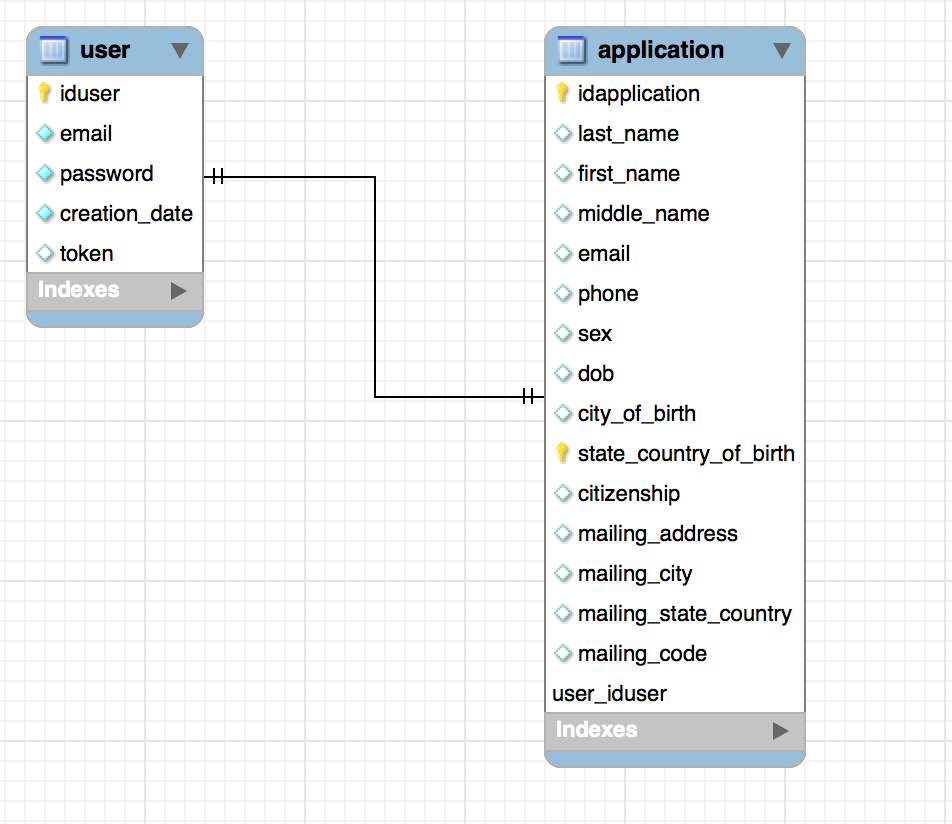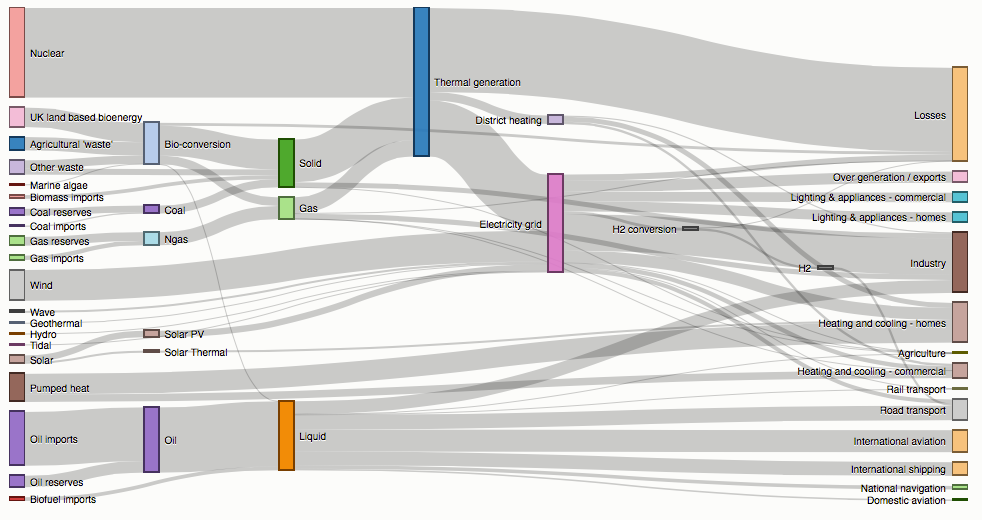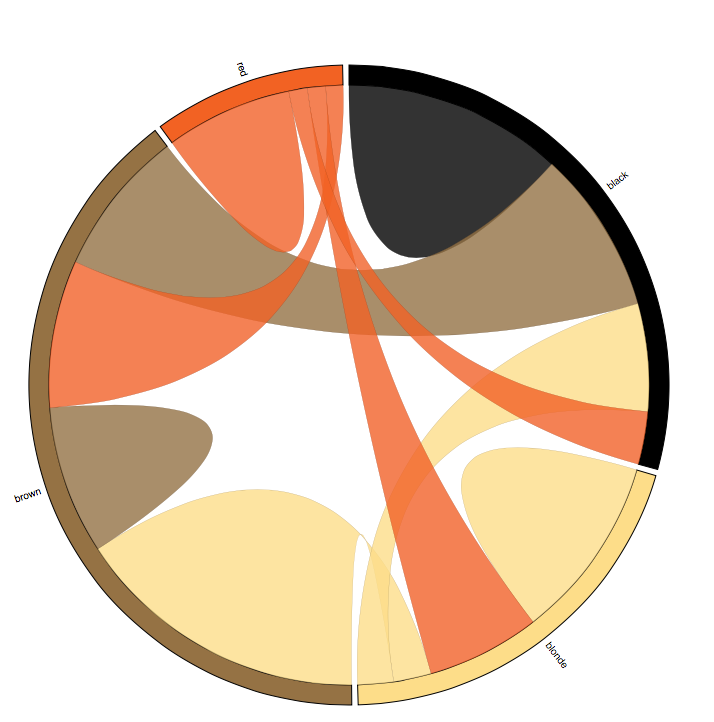
DSCI lecture 2
Survey of visualization techniques, introduction to Web technologies

Outline
- Data
- Visualization Techniques
- Introduction to WEB Technologies
Data is plural(from the latinwhat is given)
A given piece of data is called a datum
Categorical Data
| Nominal | No natural ordering $= \neq$ Ex: gender, ethnicity, nationality |
|---|---|
| Ordinal | Logical ordering but difference not meaningful $= \neq < >$ Ex: levels of happiness, levels of difficulty |
Qualified Categorical Data
Binomial (e.g., right/left, true/false)
Dichotomous (e.g., hot/cold)
vs.
Non-dichotomous (e.g., Likert scale)
Numerical Data
| Ratio | Ordered, differences & doubling meaningful, 0 fixed $= \neq < > - \%$ Ex: temperature in Kelvin ($40^{o}K = 2 \times 20^{o}K$), length, height |
|---|---|
| Interval | Ordered, differences meaningful, doubling not meaningful, 0 arbitrary $= \neq < > -$ Ex: temperature in Celsius ($40^{o}C \neq 2 \times 20^{o}C$), dates, locations |
What is the type of dollar amounts?
- Dichotomous
- Nominal
- Interval
- Ratio $\leftarrow$
What is the type of this data?
Chinese, French, American, Greek, Swiss
- Quantitative Interval
- Quantitative Ratio
- Qualitative Nominal ←
- Qualitative Ordinal
What is the type of this data in Fahrenheit scale?
$60^{o}F, 70^{o}F, 80^{o}F, 90^{o}F, 100^{o}F, 110^{o}F$
- Numerical Interval ←
- Numerical Ratio
- Categorical Nominal
- Categorical Ordinal
What is the type of this data?
| Strongly Disagree | Disagree | Neither Agree nor Disagree | Agree | Strongly Agree |
- Quantitative Interval
- Quantitative Ratio
- Categorical Ordinal ←
- Categorical Nominal
Data Models
| Conceptual | Semantic description of data entities and their relations |
|---|---|
| Logical | Implementation independent data design representation |
| Physical | Implementation dependent details by which data is actually stored |
| Conceptual model |  |
|---|---|
| Logical model |  |
| Physical model |  |
Visualization reference model

Outline
- Data
- Visualization Techniques
- Introduction to WEB Technologies
Common visualizations techniques
- Charts
- Graphs and Trees
- Clouds
- Temporal
- Geospatial and Mapping
1. Charts: dots
1. Charts: bars
1. Charts: bar layouts
1. Charts: pies
1. Charts: lines
1. Charts: line layouts
1. Charts: area
2. Graphs and Trees: hierarchies
2. Graphs and Trees: hierarchies
2. Graphs and Trees: flowcharts
Alluvial diagram

2. Graphs and Trees: networks
2. Graphs and Trees: matrix
3. Clouds
4. Temporal
5. Geospatial and Mapping: thematic maps (1)
5. Geospatial and Mapping: thematic maps (2)
5. Geospatial and Mapping: other named

Outline
- Data
- Visualization Techniques
- Introduction to WEB Technologies
The Web
- URLs (Uniform Resource Locator) used to query servers
- HTTP (Hyper Text Transfer Protocol) used to transfer
| Client | Server |
|---|---|
Browsers render:
|
Servers (e.g., node, nginx, Apache) serve:
|
Asynchronous JavaScript & HTML (AJAX)
Web languages
- HTML
- CSS
- Javascript
1. HTML
- HTML stands for
Hyper-Text Markup Language
- Defines the page semantics or meaning
- Whitespace and line breaks disregarded
- HTML document as a tree of HTML elements
- Elements specified as tags with attributes:
<tag attribute="value"></tag> - Two attributes used to identify elements:
- class:
class
of elements, multiple classes per element<tag class="definition blue"></tag> - id: uniquely identify an element, only one id per document
<tag id="tag0"></tag>
- class:
1. HTML $ > $ basic elements
| Element | Description |
|---|---|
| <!DOCTYPE html> | Standard document type declaration (first line of document). |
| html | Surrounds all HTML content in a document. |
| head | Tag containing all document metadata (e.g., title). |
| title | Title shown on top of browser window. |
| body | Visible content in the page. |
| h1, h2, h3, h4, h5, h6 | Headers of different levels. |
| p | Paragraph (block-level element). |
| span | Portion of text (inline element). |
| div | Division within the document (block-level element). |
| em | Emphasize text, rendered in italic. |
| strong, b | Emphasize text, rendered in boldface. |
| a | Hyperlink, rendered in underlined, blue text. |
| svg | SVG element for rendering vector graphics. |
1. HTML $ > $ page template (index.html)
<!DOCTYPE html>
<html>
<head>
<title>Page title</title>
</head>
<body>
<!-- This is an HTML comment -->
<!-- Visible HTML elements are placed in the body -->
</body>
</html>
1. HTML $ > $ SVG
- SVG stands for
Scalable Vector Graphics
- Used for 2D vector graphics, not for raster (images) or 3D
<svg width="800" height="260" style="background-color: honeydew">
<circle cx="300" cy="200" r="50" fill="steelblue"/>
<text x="300" y="200">Apples</text>
<circle cx="100" cy="100" r="50" fill="orange"/>
<text x="100" y="100">Pears</text>
<rect x="500" y="50" width="200" height="100" fill="orange"/>
<text x="450" y="100">Oranges</text>
</svg>
2. CSS
- CSS stands for
Cascading Style Sheets
- Used to define the appearance of HTML elements
2. CSS $ > $ including in Web pages
Inline overrides Embedded overrides External
- Inline
<p style="color: blue">Inline style</p> - Embedded
<style> p { color: blue; } </style> - External
<head> <link rel="stylesheet" type="text/css" href="style.css"> <!-- p { color: blue; } placed in style.css --> </head>
2. CSS $ > $ selectors
Selectors are specified as element name, class or id attributes
| div | div elements |
| .foo | elements with class foo |
| #foo | elements with id foo |
| div.foo | div elements with class foo |
| div#foo | div elements with id foo |
| div .foo | elements with class foo inside a div |
| div #foo | elements with id foo inside a div |
| div , .foo | div elements and elements with class foo |
| div p .foo | elements with class foo in a p in a div |
2. CSS $ > $ selectors examples
h1 {
color: red; } /* all h1 */
h1, h2 {
font-weight: bold; } /* all h1 and h2 */
h1 h2 {
font-weight: bold; } /* all h2 inside h1 */
p strong { /* all strong inside p */
color: orange;
font-weight: bold; }
#chapter1 {
color: blue } /* element with id chapter1 */
.pastoral {
color: green } /* all with class pastoral */
Later rules override earlier ones when more than one selector applies to an element
What elements the following CSS rule selects:
div,a.important {
color: 'red'
}
- Hyperlinks with class important inside a div
- Hyperlink with class important and div elements ←
- Hyperlink with id important inside a div
- Hyperlink with id important and div elements
3. Javascript

- Scripting language for Web pages
- Created by Brendan Eich
- Some resemblances with Java
- Implemented in browsers and non-browser, e.g., node
- MDN JavaScript documentation
- Web standard versions, e.g., ES5
3. Javascript $>$ uses in browsers
- User interaction
- Asynchronous communications
- Control the browser
- Alter the content
3. Javascript $>$ including in Web pages
- Inline
<script type="text/javascript"> //JavaScript code here </script> - External
<script src="script.js"></script>
3. Javascript $>$ main features
- Object-oriented language
- Everything is mutable
- Dynamic typing
- Function level scope
- First-class functions
3. Javascript $>$ main features
- Object-oriented language
//denotes a comment obj = {first: 'Joseph', last: 'Priestley'}; //object literal obj.first //'Joseph' - Everything is mutable
- Dynamic typing
- Function level scope
- First-class functions
3. Javascript $>$ main features
- Object-oriented language
- Everything is mutable
obj = {first: 'Joseph', last: 'Priestley'}; obj.first = 'Joe' //now first is 'Joe' - Dynamic typing
- Function level scope
- First-class functions
3. Javascript $>$ main features
- Object-oriented language
- Everything is mutable
- Dynamic typing
//primitive types var foo = true; //Boolean var foo = null; //Null var foo = undefined; //Undefined var foo = 2.3; //Number var foo = 'bar' //String - Function level scope
- First-class functions
3. Javascript $>$ main features
- Object-oriented language
- Everything is mutable
- Dynamic typing
- Function level scope
var b = 5; //global scope, i.e., at the top of the script function f(a) { var b = 3; //local scope, i.e., within the scope of the function return a + b; } b; //5 - First-class functions
3. Javascript $>$ main features
- Object-oriented language
- Everything is mutable
- Dynamic typing
- Function level scope
- First-class functions
//functions treated similar to any other variable var pi = function() { return Math.PI; } //assign functions to a variable function add(a, f) { return a + f(); } add(1, pi); //pass functions as argument function addPi() { return function(a) { //return functions return a + Math.PI; } }
3. Javascript $ > $ hoisting
Hoisting refers to the moving of variable declarations at the top of their scope when the script is parsedDeclarations are moved, initializations are not moved
Before hoisting
var a; //declare
a = 2; //initialize
var b; //declare
b = 5; //initialize
//function expression: declare & initialize
var add = function (a, b) {
return a + b;
}; //; at the end!
//function declaration
function func(a) {
var b = 3; //declare & initialize
var c = a + b; //declare & initialize
return c;
}
After hoisting
var a; //hoisted
var b; //hoisted
var add; //hoisted
function func(a) { //hoisted
var b; //hoisted
var c; //hoisted
b = 3;
c = a + b;
return c;
}
a = 2;
b = 5;
add = function (a, b) {
return a + b;
};
3. Javascript $>$ closure
A closure is the combination of a function and the lexical
environment within which that function was declared.
function exampleClosure(arg1, arg2) { //closure example
var localVar = 2;
function exampleReturned(innerArg) { //inner function (declaration)
return ((arg1 + arg2) / (localVar + innerArg));
}
return exampleReturned; //reference to inner function
}
var globalVar = exampleClosure(2, 4);
console.log(globalVar); //[Function: exampleReturned]
globalVar(4); //1 = ((2 + 4) / (2 + 4))
Javascript ES6 to know
//...
const { NEIGHBORHOOD_MAP } = require('../lib/utils/xtown-api');
let neighborhoodIds = [];
printNewsCmd.neighborhoods.forEach(d => {
let ids = NEIGHBORHOOD_MAP.get(d).id;
if (!ids) {
console.log(danger('ERROR'));
console.log(danger('No such neighborhood id "' + info + '"'));
exit(0);
}
ids = Array.isArray(ids) ? ids : [ids];
neighborhoodIds = neighborhoodIds.concat(ids);
});
neighborhoodIds = [...new Set(neighborhoodIds)]; //remove duplicates
const { printNews } = require('../lib/utils/printer');
printNews({
print_settings: {
neighborhoods: neighborhoodIds,
image: {
dir: FOUNDRY_CONFIG.print_defaults.news.image.dir,
format: printNewsCmd.imageFormat,
width: +printNewsCmd.imageWidth,
height: +printNewsCmd.imageHeight
},
user: user,
},
news: fs.readJSONSync(newsFile)
}).then(result => {
console.log(info('PRINT:'));
console.log(info(' id:'), important(result.print.id));
console.log(info(' path:'), important(result.print_settings.path));
console.log(info(' file:'), important(result.print.file));
console.log(info('PRINTS:'));
result.print_settings.neighborhoods.forEach(d => {
console.log(info(' ' + d + ':'));
console.log(info(' file:'), important(result.print_settings.path + d + '/index.html'));
console.log(info(' url:'), important(FOUNDRY_CONFIG.prints_url + result.print.id + '/' + d + '/index.html'));
});
if (printNewsCmd.verbose) {
console.log(info('\ntrace'));
console.dir(result, CONSOLE_DIR_OPTIONS);
}
}).catch(err => {
console.log(danger('ERROR'));
console.dir(err, CONSOLE_DIR_OPTIONS);
});
//...
Javascript ES6 to know (continued)
/**
* print news
* @param {Object} context print context
* @returns {Object} printed object
*/
const printNews = context => {
return new Promise((resolve, reject) => {
const { FOUNDRY_CONFIG } = require('../config');
const { v4: uuidv4 } = require('uuid');
context.print = {
id: uuidv4(),
news_id: context.news.id,
created: {
user: context.print_settings.user,
timestamp: Date.now(),
},
errors: []
};
context.print_settings = context.print_settings ? context.print_settings : FOUNDRY_CONFIG.print_defaults.news;
context.print_settings.path = context.print_settings.path ? context.print_settings.path : FOUNDRY_CONFIG.prints_path;
context.print_settings.path += context.print.id + '/'; //prints folder
const { NEIGHBORHOOD_MAP } = require('./xtown-api');
let neighborhoods = [];
context.print_settings.neighborhoods.forEach(d => {
let ids = NEIGHBORHOOD_MAP.get(d).id;
if (!ids) {
reject(err);
return;
}
ids = Array.isArray(ids) ? ids : [ids];
neighborhoods = neighborhoods.concat(ids);
});
context.print_settings.neighborhoods = [...new Set(neighborhoods)]; //remove duplicates
fs.ensureDirSync(context.print_settings.path);
const newsFile = context.print_settings.path + context.print.id + FOUNDRY_CONFIG.json_ext;
fs.writeJSONSync(newsFile, {...context.print, neighborhoods: context.print_settings.neighborhoods});
context.print.file = newsFile;
printNewsFiles(context).then(results => {
resolve(context);
}).catch(e => reject(e));
});
}





































